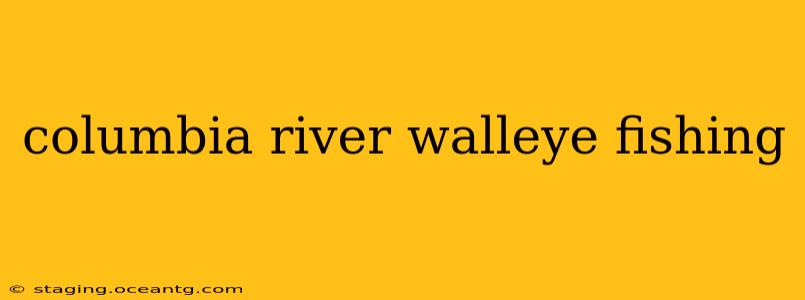The Columbia River, a majestic waterway spanning Washington and Oregon, offers anglers a thrilling opportunity to pursue a prized game fish: the walleye. Known for their fighting spirit and delicious flesh, walleye in the Columbia River present a unique and rewarding fishing experience. This guide delves into the specifics of Columbia River walleye fishing, covering techniques, locations, seasons, and regulations to ensure a successful and responsible trip.
Where to Find Walleye in the Columbia River?
Walleye distribution within the Columbia River system isn't uniform. They prefer specific habitat conditions, influencing where you're most likely to find success. Generally, look for areas with:
- Deep Pools and Eddies: Walleye are ambush predators, often lurking in deeper water near structure. Look for areas with slow currents, deep pools, and submerged logs or rocks.
- River Channels: The main river channels often hold larger concentrations of walleye, especially during the cooler months.
- Near-Shore Structure: Along the banks, areas with submerged trees, weed beds (where present), and drop-offs provide excellent cover and attract baitfish, thus attracting walleye.
- Mouths of Tributaries: The confluence of tributaries with the main river can create favorable conditions for walleye. These areas often have diverse habitat and currents.
Specific locations vary based on the section of the Columbia River you're fishing. Local fishing reports and guides can offer invaluable insight into the current hot spots.
What Time of Year is Best for Walleye Fishing on the Columbia River?
The best time for Columbia River walleye fishing generally falls during the spring and fall.
- Spring: As water temperatures rise, walleye become more active and begin their spawning run. This period often provides excellent fishing opportunities.
- Fall: As water temperatures cool, walleye again become more active, feeding heavily to prepare for winter. This is another peak time for catching larger specimens.
Summer fishing can be productive, but it often requires adjusting techniques to account for warmer water temperatures and potential changes in walleye behavior. Winter fishing can be challenging due to colder temperatures and decreased walleye activity.
What are the Best Baits and Lures for Columbia River Walleye?
Success in walleye fishing often hinges on choosing the right bait or lure. Walleye are opportunistic feeders, so experimenting is key. However, several proven techniques consistently yield results:
- Live Bait: Minnows, nightcrawlers, and leeches are highly effective, particularly when fished near the bottom.
- Jigs: Jigging with plastic grubs or minnow-shaped lures is a popular technique, especially in deeper water.
- Spinnerbaits: These lures imitate baitfish and can be effective in both shallow and deeper areas.
- Crankbaits: Crankbaits, particularly those that dive to mid-depths, can be highly productive.
- Trolling: Trolling crankbaits or other lures behind a boat is an effective method for covering large areas.
Experimentation with colors and lure sizes is crucial. Matching the lure to the available forage in the area can significantly increase your chances of success.
What are the Regulations for Walleye Fishing on the Columbia River?
Fishing regulations for walleye on the Columbia River vary depending on the specific location and time of year. Always check the most up-to-date regulations with the relevant state agencies (Washington Department of Fish and Wildlife and Oregon Department of Fish and Wildlife) before you go fishing. These agencies will provide detailed information on:
- Daily limits: The number of walleye you're allowed to catch per day.
- Size limits: Minimum and maximum size restrictions for keeping walleye.
- Fishing seasons: When walleye fishing is permitted.
- Special regulations: Any additional restrictions, such as gear restrictions or closed areas.
Failure to comply with these regulations can result in penalties. Responsible fishing practices are essential to maintain the health of the walleye population for future generations.
What is the Best Fishing Technique for Walleye on the Columbia River?
There's no single "best" technique, as the most effective approach depends on several factors, including water conditions, walleye activity, and the specific location. However, some consistently productive strategies include:
- Bottom bouncing: Using a jig and plastic or live bait, slowly dragging along the river bottom.
- Vertical jigging: Dropping a jig straight down and using a slow, rhythmic retrieve.
- Trolling: Covering larger areas by dragging lures behind a moving boat.
Experiment with different techniques to determine what works best for the particular conditions.
What Tackle and Equipment Do I Need for Walleye Fishing on the Columbia River?
Appropriate tackle is vital for a successful fishing trip. You'll need:
- Rod and Reel: A medium-light to medium-heavy spinning or baitcasting rod and reel combo, suitable for handling the weight of your chosen lures and baits.
- Line: 8-12 lb test braided line is a popular choice, offering sensitivity and strength.
- Hooks: Size and type will depend on your chosen bait or lure.
- Weights: Sinker weights to help your lures reach the desired depth.
- Leader: Fluorocarbon leader can improve stealth and reduce line visibility.
- Lures & Baits: A variety of lures and live bait options.
- Accessories: Fishing pliers, a net, and a tackle box for organization.
By understanding the intricacies of walleye behavior, selecting the right locations and techniques, and adhering to regulations, anglers can significantly improve their chances of a successful and memorable Columbia River walleye fishing experience. Remember to always prioritize safety and respect the environment.
